Thursday, 28 June, Pasteur, emergency first aid, and sauerkraut
Written 2 August 2018

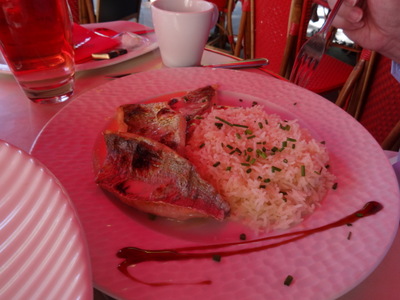 And time for another attempt to visit the Pasteur exhibition. So once again, we took the metro to Invalides, walked back across the AIII bridge, and settled in for lunch at the Grand Palais, where once again the awning turned all our food red. This time, I ordered the scrambled eggs with s,oked salmon, which were outstanding (so soft they were served in a bowl and a normal scrambled egg color with salmon-colored salmon, not the pink they appear in the photo.
And time for another attempt to visit the Pasteur exhibition. So once again, we took the metro to Invalides, walked back across the AIII bridge, and settled in for lunch at the Grand Palais, where once again the awning turned all our food red. This time, I ordered the scrambled eggs with s,oked salmon, which were outstanding (so soft they were served in a bowl and a normal scrambled egg color with salmon-colored salmon, not the pink they appear in the photo.
David had the "plat du jour," which was sautéed filets of daurade (gilt-head sea bream) with rice. The fish was great, drizzled with a buttery lemon sauce, and the rice was excellent (cooked in a broth of some sort that made it much more flavorful than ordinary rice).
While we ate, though, we witnessed a small but very instructive drama. A middle-aged man with a briefcase was crossing the street toward us when he tripped and fell headlong. We were in the second row of tables and couldn't easily get out, but people at the tables in front of up hopped up and ran out to help him. Fortunately, traffic was light. One guy whipped out his cell phone and called emergency services, then stayed on the line until the victim could be helped up, guided across the rest of the street, and put in a chair at the café. They he handed the phone to the victim, so that he could talk directly to the medics. Meanwhile, the waiter brought ice in a cloth napkin to put on his scraped face, and everyone offered paper napkins and tissues to wipe off the blood. Others collected and brought him his briefcase and the pieces of his shattered glasses (the lenses were intact, but the frame was bent and broken, and both lenses had fallen out). He had fallen just where there was a curb cut with those little hemispherical bumps on it to warn the blind, and he must have hit his head on those, because he was bleeding all down the side of his face, and above his right eyebrow he developed, within moments, a bump the size of a golf ball.
Less than five minutes after the initial call, a bright red fire-department first-aid van came wailing and flashing to the curb, and the medics it brought took over the wound care. They offered to call someone for him, then lent him a phone when he said he could do it himself—he just needed to tell someone he'd be late for his meeting. Eventually, they loaded him and his effects into the van and drove off with him. All this made me realize that, in the case of an emergency, I had no idea of the European equivalent of 911. A graphic on the side of the first-aid van clearly indicated the numbers "112" and "18," with a slash between them. Not sure what that meant, I looked it up later on line and then asked our Uber driver on the way to the airport. Here's the upshot. Anywhere in Europe, for any kind of emergency, you can call 112, and they'll help you out. But in France, there's a whole system of emergency-specific numbers you can call instead, if you need them. "18" is for fire or first aid, "15" for an ambulance, "17" for police. Then the three-digit numbers start. There are three-digit numbers specific to all kinds of emergencies: maritime emergencies, missing child, kidnapping or terrorist threat, aircraft in distress, child protective services. There's even a three-digit number to call if you are in danger of becoming homeless or know of someone who is. Now I know who to call.
The Uber driver even explained the billing system. An appointment with a doctor is 38 euros (what the doctor at the airport charged us for stitching up David's eyebrow), but any emergency situation, like the one we witnessed or an ambulance ride for a more serious accident, is free.
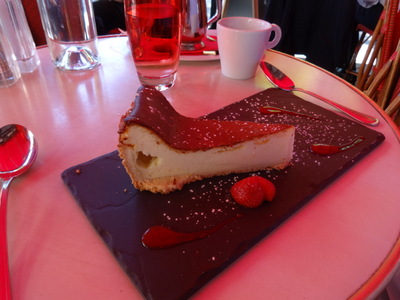
 Once the excitement died down, we split the dessert that came with David's plat du jour: cheese tart. Somewhat cheesecake-like, but dryer and browned on top. Pretty good.
Once the excitement died down, we split the dessert that came with David's plat du jour: cheese tart. Somewhat cheesecake-like, but dryer and browned on top. Pretty good.
Then we headed across the street and this time were successful in getting into the Palais de la Découverte to see Pasteur. The photo at the right is of the entrance hall, which has the same grand architecture as the "Grand Palais" entrance on the other side, but somewhat marred by all the scaffolding that holds up the partitions enclosing the ticket offices.
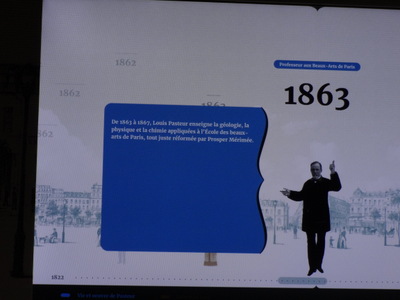
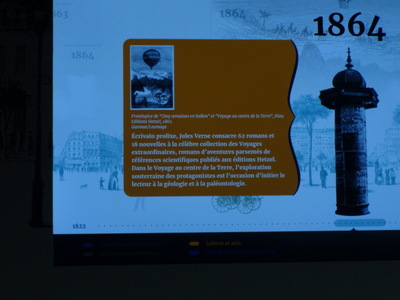 Everybody knows about pasteurization, right? But Pasteur did much more than that and much more than I ever knew! He worked on crystals and dissymetry (i.e., why two compounds of exactly the same elemental composition could have such different properties), the process of fermentation (and problems that interfered with it in the wine-making industry), spontaneous generation (he definitively disproved it), diseases that were decimating the French silkworm industry (he didn't know anything about silkworms, but he figured out and fixed the problem anyway), anthrax in sheep (he figured out how it was transmitted and how to stop it), and vaccines. He was the first to demonstrate the existing of anaerobic organisms. He sorted out the different kinds of fermentation (alcoholic, lactic, butyric, acetic) and the organisms specific to each
Everybody knows about pasteurization, right? But Pasteur did much more than that and much more than I ever knew! He worked on crystals and dissymetry (i.e., why two compounds of exactly the same elemental composition could have such different properties), the process of fermentation (and problems that interfered with it in the wine-making industry), spontaneous generation (he definitively disproved it), diseases that were decimating the French silkworm industry (he didn't know anything about silkworms, but he figured out and fixed the problem anyway), anthrax in sheep (he figured out how it was transmitted and how to stop it), and vaccines. He was the first to demonstrate the existing of anaerobic organisms. He sorted out the different kinds of fermentation (alcoholic, lactic, butyric, acetic) and the organisms specific to each
He was also an entrepreneur, patenting things like a new type of beer, an anthrax vaccine, and a pasteurization system./p>

 The presentation of all this information was very varied and calculated to pull the viewer in. For kids, there were games and quizzes. For grown-ups, there was a strange puppet show—half puppets, half CGI, that presented Pasteur's debate with a contemporary over the question of the existence of spontaneous generation. Pasteur trounced him, of course.
The presentation of all this information was very varied and calculated to pull the viewer in. For kids, there were games and quizzes. For grown-ups, there was a strange puppet show—half puppets, half CGI, that presented Pasteur's debate with a contemporary over the question of the existence of spontaneous generation. Pasteur trounced him, of course.
A presentation that absolutely transfixed us and kept us standing in one spot for a long time was a screen on which dated information bits appeared. It was controlled by a scroll wheel, which a fellow viewer was systematically stepping through, and David and I watched over his shoulder all the way through. The four images given above and here are excerpts from it. It started with the year Pasteur was born, presenting historic events that took place that year, one fact per slide, so sometimes several successive slides bore the same year, and ended with the year of his death. It really put his work in its historical context.
I took a photo of each one as it went by, to study later, but the four I show here, starting at the left above, are (1) 1864: Louis Pasteur teaches geology, physics, and applied chemistry at the School of Fine Arts in Paris, just reformed by Prosper Merimée. (2) 1864: Describes the works of Jules Verne, exphasizing their scientific content. (3) 1965: Mendel works out the principles of heridity. (4) 1865: Pasteur develops and patents an apparatus for pasteurizing wine so that it could be shipped in sealed containers without changing its character over time.
Written 4 August 2018
From the many displays, I learned, among many other things, the dates of invention of the petri dish and the dates and order in which various culture media were developed, from liquid through agar and gelatin, to use of potato as the first solid medium.

 A large map of France on one wall bore markers pointing out the various locations around the country where Pasteur responded to calls for help and where he was able to find solutions. At the left, Lille for diseases of sugar beet; Marnes-la-Coquette for rabies; Strasbourg, here he made breakthroughs in the study of crystalization; and Paris, where he also worked on crystals, cholera in chicken, anthrax, and rabies.
A large map of France on one wall bore markers pointing out the various locations around the country where Pasteur responded to calls for help and where he was able to find solutions. At the left, Lille for diseases of sugar beet; Marnes-la-Coquette for rabies; Strasbourg, here he made breakthroughs in the study of crystalization; and Paris, where he also worked on crystals, cholera in chicken, anthrax, and rabies.
At the right, Clermont-Ferrand for problems with beer brewing and Alès, where he solved the silkworm problem. He studied slides from healthy and diseased silkworms and identified the mysterious little bodies present in the latter but not in the former. The real problem was that the little bodies (bacteria, as it happens, though he couldn't be sure at the time) were transmitted from generation to generation right in the silkworms' eggs. He showed the growers how to spot the eggs contaminated with the little bodies and to sort them (under the microscope) from eggs that didn't contain any, then to grow their next generation of worms from only the good eggs. Careful sanitation and a few generations of careful sorting got them out of the woods.
I came away knowing a lot more about Pasteur and the foundation he started, which is still going strong, promoting and funding science and science education. And along the way, I learned a bunch of related science that I hadn't known. Good exhibition.
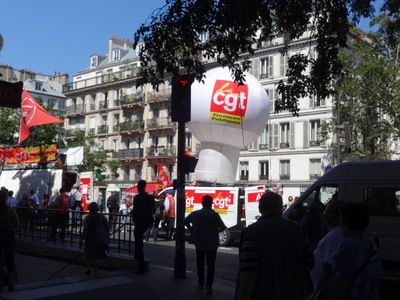
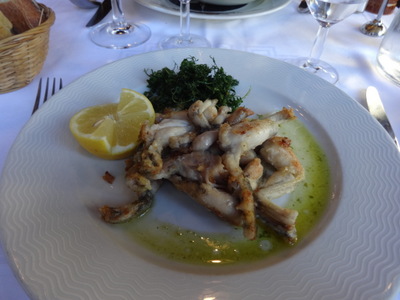 This was our last full day in Paris, and we had to be up and out quite early in the morning to catch our flight home, so we decided to keep dinner low key. As we emerged from the metro on the way home from the museum, though, we were treated to one more typical Paris sight—a political demonstration. This one was mostly stationary, although theoretically a march or parade. From the Filles du Calvaire metro stop, it stretched forward as far as we could see toward Place de la République and back as far as we could see toward Place de la Bastille. I couldn't immediately parse the initials on the balloons, but I looked it up later—CGT stands for "Conseil Général du Travail," which is the French union of labor unions. The banners said things like "We work while they speculate; that's enough!" and "Stop the austerity. The wealth is there; spread it around."
This was our last full day in Paris, and we had to be up and out quite early in the morning to catch our flight home, so we decided to keep dinner low key. As we emerged from the metro on the way home from the museum, though, we were treated to one more typical Paris sight—a political demonstration. This one was mostly stationary, although theoretically a march or parade. From the Filles du Calvaire metro stop, it stretched forward as far as we could see toward Place de la République and back as far as we could see toward Place de la Bastille. I couldn't immediately parse the initials on the balloons, but I looked it up later—CGT stands for "Conseil Général du Travail," which is the French union of labor unions. The banners said things like "We work while they speculate; that's enough!" and "Stop the austerity. The wealth is there; spread it around."
When we came back out later to walk up to Chez Jenny, the whole thing was over and the streets were empty again (at least of demonstrators).
At Chez Jenny, I was sorely tempted by the cold seafood platters, but David absolutely hates it when I order those, so I refrained. Instead, I started with frogs' legs "en persillade." At the right, you can see them, in a pool of melted butter with a heap of fried parsley on the side. Delicious!
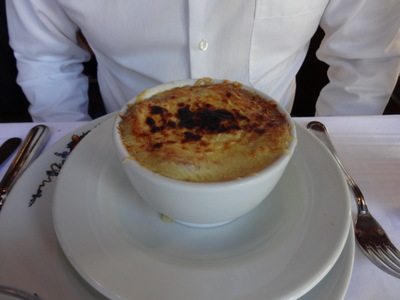
 David started with the onion soup again, with croutons and melted cheese on top.
David started with the onion soup again, with croutons and melted cheese on top.
His main course was sauerkraut with "haddock." Too late, we remembered that the French call fresh haddock "aiglefin." When they say "haddock," they mean finnan haddie, smoked haddock. Fortunately, he likes that as well. That's it at the right, leaning on a mound of sauerkraut (laced with all sorts of aromatic seeds: juniper berries, carraway, cumin, mustard). Beside it, a boiled potato and around it a pool of beurre blanc (a sauce with the flavors of hollandaise but much thinner and flavored with shallots).


My main course was "sauerkraut of the sea," braised sauerkraut topped with salmon, "haddock," daurade, and a big pink shrimp (for an extra 15 euros, I could have had them add half a lobster). I also got boiled potatoes and beurre blanc. It was all topped with a tangle of parsley and dill. It was all perfectly delicious, but neither of us could finish all that sauerkraut; we must have gotten close to a pound each.
For dessert, David chose the special, a large millefeuille (Napoleon).
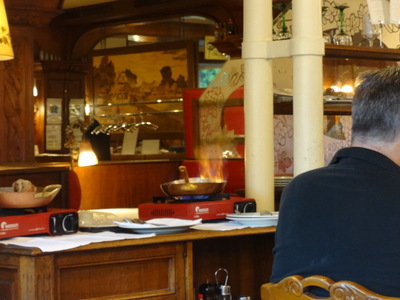
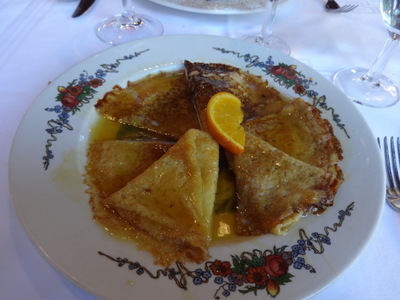 I picked the crêpes flambées au Grand Marnier. At the left is the burner on the sideboard where the waiter sautéed my crepes in butter and sugar cubes that had been rubbed over an orange rind to soak up the oil. He then squeezed some of the orange juice into the pan, pour in Grand Marnier, right from the bottle, and flamed the whole thing. Only then did he step out of the way to let the flames subside and to let me get this photo of the flames.
I picked the crêpes flambées au Grand Marnier. At the left is the burner on the sideboard where the waiter sautéed my crepes in butter and sugar cubes that had been rubbed over an orange rind to soak up the oil. He then squeezed some of the orange juice into the pan, pour in Grand Marnier, right from the bottle, and flamed the whole thing. Only then did he step out of the way to let the flames subside and to let me get this photo of the flames.
On a similar burner to the left of this one, he kept a large skillet warm for two guys who had ordered the "traditional" "choucroute garni": sauerkraut topped with pork chine, smoked cumin sausages, white sausages, smoked pork breast, and pork hock. He piled some of everything on each guys plate, then kept the rest warm for seconds.
At the right is my plate of crépes, a little thicker and more substantial than some, and still pretty alcoholic, despite the flaming, but strongly flavored with caramelized orange and entirely delicious. I even ate the orange slice, peel and all.
Previous entry
List of Entries
Next entry

 And time for another attempt to visit the Pasteur exhibition. So once again, we took the metro to Invalides, walked back across the AIII bridge, and settled in for lunch at the Grand Palais, where once again the awning turned all our food red. This time, I ordered the scrambled eggs with s,oked salmon, which were outstanding (so soft they were served in a bowl and a normal scrambled egg color with salmon-colored salmon, not the pink they appear in the photo.
And time for another attempt to visit the Pasteur exhibition. So once again, we took the metro to Invalides, walked back across the AIII bridge, and settled in for lunch at the Grand Palais, where once again the awning turned all our food red. This time, I ordered the scrambled eggs with s,oked salmon, which were outstanding (so soft they were served in a bowl and a normal scrambled egg color with salmon-colored salmon, not the pink they appear in the photo.
 Once the excitement died down, we split the dessert that came with David's plat du jour: cheese tart. Somewhat cheesecake-like, but dryer and browned on top. Pretty good.
Once the excitement died down, we split the dessert that came with David's plat du jour: cheese tart. Somewhat cheesecake-like, but dryer and browned on top. Pretty good.
 Everybody knows about pasteurization, right? But Pasteur did much more than that and much more than I ever knew! He worked on crystals and dissymetry (i.e., why two compounds of exactly the same elemental composition could have such different properties), the process of fermentation (and problems that interfered with it in the wine-making industry), spontaneous generation (he definitively disproved it), diseases that were decimating the French silkworm industry (he didn't know anything about silkworms, but he figured out and fixed the problem anyway), anthrax in sheep (he figured out how it was transmitted and how to stop it), and vaccines. He was the first to demonstrate the existing of anaerobic organisms. He sorted out the different kinds of fermentation (alcoholic, lactic, butyric, acetic) and the organisms specific to each
Everybody knows about pasteurization, right? But Pasteur did much more than that and much more than I ever knew! He worked on crystals and dissymetry (i.e., why two compounds of exactly the same elemental composition could have such different properties), the process of fermentation (and problems that interfered with it in the wine-making industry), spontaneous generation (he definitively disproved it), diseases that were decimating the French silkworm industry (he didn't know anything about silkworms, but he figured out and fixed the problem anyway), anthrax in sheep (he figured out how it was transmitted and how to stop it), and vaccines. He was the first to demonstrate the existing of anaerobic organisms. He sorted out the different kinds of fermentation (alcoholic, lactic, butyric, acetic) and the organisms specific to each
 The presentation of all this information was very varied and calculated to pull the viewer in. For kids, there were games and quizzes. For grown-ups, there was a strange puppet show—half puppets, half CGI, that presented Pasteur's debate with a contemporary over the question of the existence of spontaneous generation. Pasteur trounced him, of course.
The presentation of all this information was very varied and calculated to pull the viewer in. For kids, there were games and quizzes. For grown-ups, there was a strange puppet show—half puppets, half CGI, that presented Pasteur's debate with a contemporary over the question of the existence of spontaneous generation. Pasteur trounced him, of course.
 A large map of France on one wall bore markers pointing out the various locations around the country where Pasteur responded to calls for help and where he was able to find solutions. At the left, Lille for diseases of sugar beet; Marnes-la-Coquette for rabies; Strasbourg, here he made breakthroughs in the study of crystalization; and Paris, where he also worked on crystals, cholera in chicken, anthrax, and rabies.
A large map of France on one wall bore markers pointing out the various locations around the country where Pasteur responded to calls for help and where he was able to find solutions. At the left, Lille for diseases of sugar beet; Marnes-la-Coquette for rabies; Strasbourg, here he made breakthroughs in the study of crystalization; and Paris, where he also worked on crystals, cholera in chicken, anthrax, and rabies.
 This was our last full day in Paris, and we had to be up and out quite early in the morning to catch our flight home, so we decided to keep dinner low key. As we emerged from the metro on the way home from the museum, though, we were treated to one more typical Paris sight—a political demonstration. This one was mostly stationary, although theoretically a march or parade. From the Filles du Calvaire metro stop, it stretched forward as far as we could see toward Place de la République and back as far as we could see toward Place de la Bastille. I couldn't immediately parse the initials on the balloons, but I looked it up later—CGT stands for "Conseil Général du Travail," which is the French union of labor unions. The banners said things like "We work while they speculate; that's enough!" and "Stop the austerity. The wealth is there; spread it around."
This was our last full day in Paris, and we had to be up and out quite early in the morning to catch our flight home, so we decided to keep dinner low key. As we emerged from the metro on the way home from the museum, though, we were treated to one more typical Paris sight—a political demonstration. This one was mostly stationary, although theoretically a march or parade. From the Filles du Calvaire metro stop, it stretched forward as far as we could see toward Place de la République and back as far as we could see toward Place de la Bastille. I couldn't immediately parse the initials on the balloons, but I looked it up later—CGT stands for "Conseil Général du Travail," which is the French union of labor unions. The banners said things like "We work while they speculate; that's enough!" and "Stop the austerity. The wealth is there; spread it around."
 David started with the onion soup again, with croutons and melted cheese on top.
David started with the onion soup again, with croutons and melted cheese on top.



 I picked the crêpes flambées au Grand Marnier. At the left is the burner on the sideboard where the waiter sautéed my crepes in butter and sugar cubes that had been rubbed over an orange rind to soak up the oil. He then squeezed some of the orange juice into the pan, pour in Grand Marnier, right from the bottle, and flamed the whole thing. Only then did he step out of the way to let the flames subside and to let me get this photo of the flames.
I picked the crêpes flambées au Grand Marnier. At the left is the burner on the sideboard where the waiter sautéed my crepes in butter and sugar cubes that had been rubbed over an orange rind to soak up the oil. He then squeezed some of the orange juice into the pan, pour in Grand Marnier, right from the bottle, and flamed the whole thing. Only then did he step out of the way to let the flames subside and to let me get this photo of the flames.